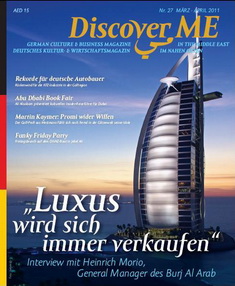
Article:
ISSUE No.5 July - August 2007
A Thousand and One Nights
Stories from the East
The depiction “A Thousand and One Nights” is commonly used and brings forth romantic visions of this region. Stories of Ali Baba and the forty thieves, Aladdin and the magic lamp and also the portrayals of these characters and descriptions of Scheherazade on film and on stage have assured them their place in world literature.
Researchers all over the world have been trying to find the origin of “A Thousand and One Nights”. We know today that the works originated in India and Persia and ultimately the Arabian area. The Indian stories made it to Persia where they were translated into middle-Persian. According to tales passed on through the years, the works were translated into the Arabic language in the eighth century. During that process Alf Layla’s work “A Thousand and One Nights” was enhanced with Islamic formulas and quotes. With the passage of time it became a sizeable collection of Eastern stories. The basic principle is simple yet thrilling and runs continuously through the events. A framework is established and combined with the actual story that puts the reader into a spell starting with the first page. The writer used a flowery way to intertwine historic events, funny anecdotes, comedy, tragedy and romance. The story of the beautiful Scheherazade, who with the help of her stories not only saved her own life, but also those of many other women, still enchants us today.
The handwritten translation by Antoine Galland into French is the oldest European translation of these Arabian collections. It dates back to 1450 and stopped abruptly after the 282nd night. Galland was a French orientalist and archeologist, specializing in numismatics. He was well versed in Arabic, Persian and Turkish. While translating the stories, he censored them by lowering the religious and erotic contents, thus we have the misconception they are children’s fairy tales.
The Frenchman also added the legends of Sinbad and the Seafarers, Aladdin and the Magic Lamp and Ali Baba and the Forty Thieves to the original manuscript. These stories were not in the Arabian version; Galland heard them from a Syrian man whom he met in Paris.
In the 18th century, “A Thousand and One Nights” was the second most popular book in Europe after the Bible. The stories came with perfect timing and started an Oriental boom. The yearning for adventure, things exotic and foreign lands was being satisfied and in the following centuries, the stories were repeatedly translated and published. In their homeland they were considered trivial but were read anyway. It wasn’t until the 18th and 19th centuries that Arabian literary world noticed the importance of these works in Europe. Finally they received the credit they deserved.
To this day, the stories of “A Thousand and One Nights” have their place among the literary greats. The first German translation was published in 2004 by Claudia Ott. She tackled the difficult task and translated the original manuscripts.
